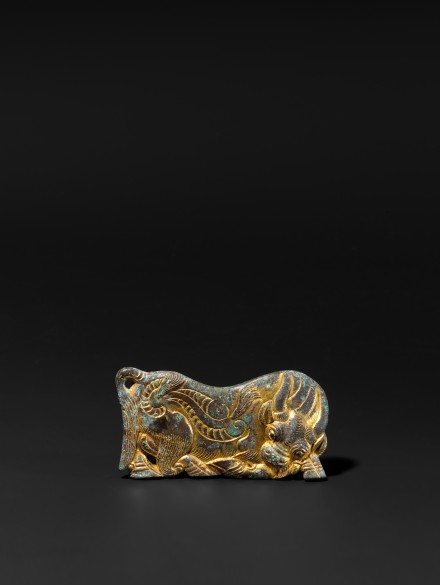J.J. Lally & Co., Oriental Art / New York City, New York
MenuPast Exhibition
Chinese Art: The Szekeres Collection
March 13-29, 2019

27.
AN ORDOS GILT BRONZE BOVINE PLAQUE
North China, 2nd – 1st Century B.C.
cast in relief in the form of an ox with curved horns and pointed ears, shown recumbent with head turned back towards the long tail, the sharp hooves lined up along the lower margin, the thick pelt indicated by striations and embellished with ribbed scroll motifs, the design highlighted by extensive remains of bright gilding, the reverse plain and with two loops for attachment.
Length 4 1⁄4 inches (10.5 cm)
Provenance
Collection of Richard H. Kimball, Denver, CO
J. J. Lally & Co., New York, 1991
Compare the similar gilt bronze plaque unearthed from Subao, Xiji county, Ningxia province, now in the collection of the Xiji County Currency Museum, published by Cao (ed.), Mengya, chengzhang, ronghe: Dong Zhou shiqi beifang qingtong wenhua zhencui (Rise, Growth and Cultural Integration: The Quintessential Pieces of Northern Bronze Culture During the Eastern Zhou Period), Xi’an, 2012, p. 82.
Compare also a belt buckle comprised of two similar plaques published by Bunker in the Metropolitan Museum of Art exhibition catalogue, Nomadic Art of the Eastern Eurasian Steppes, New Haven, 2002, p. 98-99, no. 65.
Another similar plaque is published in the Tokyo National Museum catalogue, Daisōgen no kiba minzoku: Chūgoku hoppō no seidōki (Mounted Nomads of Asian Steppe: Chinese Northern Bronzes), Tokyo, 1997, no. 224 with description on p. 185.
中國北方 銅鎏金犛牛形帶飾 長 10.5 厘米
27.
AN ORDOS GILT BRONZE BOVINE PLAQUE
North China, 2nd – 1st Century B.C.
Length 4 1⁄4 inches (10.5 cm)